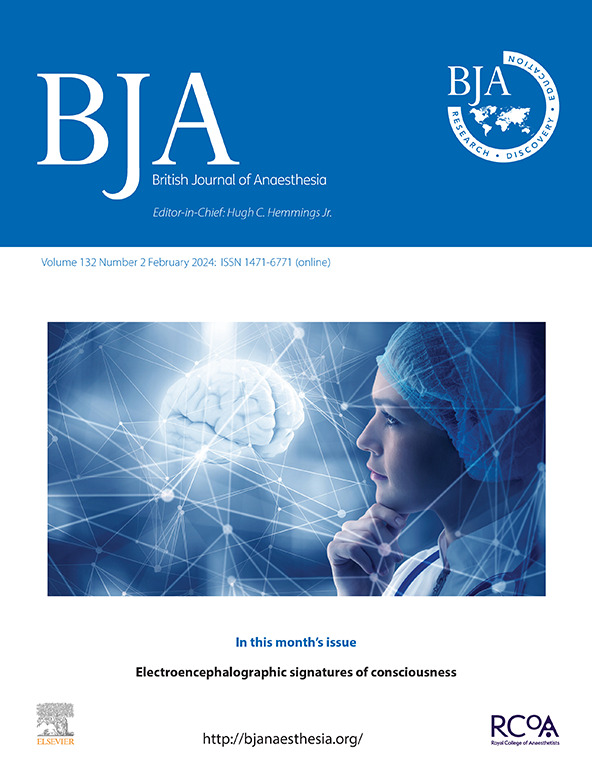地理隔离、乡村性和危重疾病后的结果:2010-2021年苏格兰重症监护病房急诊入院的回顾性队列研究
IF 9.2
1区 医学
Q1 ANESTHESIOLOGY
引用次数: 0
摘要
背景:乡村性、地理隔离和重症监护结果之间的联系是复杂的,对健全的医疗保健系统的设计和实施是重要的。因此,我们对2010-21年苏格兰重症监护病房急诊入院的成人(≥16岁)进行了回顾性队列研究。方法将数据与全国住院记录、重症监护数据库和死亡率记录相关联。地理隔离由前往重症监护病房(ICU)和急诊科的模拟旅行时间确定,乡村性由国家八重城乡分类确定。计算标准化的住院率,并对隔离和农村地区与ICU和住院时间有关的全因死亡率进行生存分析,以及重症监护入院后一年内的急诊再入院率。结果在研究期间,共有50914例ICU首次急诊入院患者被纳入分析。与距离ICU <30分钟的地区相比,距离ICU≥180分钟的地区的年龄-性别标准化入院率低24.2%(95%置信区间19.4-28.2%)。未发现死亡率与任何类型的隔离之间存在显著关联。其他城市地区(1万至124 999人的居住区)的死亡率高于大城市地区(≥12.5万人的居住区)(校正风险比1.05,95%置信区间1.01-1.08)。结论偏远地区和农村地区患者重症监护率较低。进一步的研究应该探索这些发现的机制,并考虑在偏远地区加强重症监护转移和资源的获取是否可能改善健康结果。本文章由计算机程序翻译,如有差异,请以英文原文为准。
Geographic isolation, rurality, and outcomes after critical illness: a retrospective cohort study of emergency admissions to critical care units in Scotland 2010-2021.
BACKGROUND
The association between rurality, geographic isolation, and outcomes in critical care is complex, and important to the design and implementation of robust healthcare systems. We therefore conducted a retrospective cohort study of adult (≥16 yr) emergency admissions to critical care units in Scotland 2010-21.
METHODS
Data were linked across national inpatient records, the critical care database, and mortality records. Geographic isolation was determined by modelled travel time to the intensive care unit (ICU) and emergency department, and rurality by the national eight-fold Urban Rural Classification. Standardised admission rates were calculated, alongside survival analysis for all-cause mortality by isolation and rurality with ICU and hospital length of stay, and emergency hospital readmissions in the year after critical care admission.
RESULTS
A total of 50 914 first emergency admissions to the ICU over the study period were included in the analyses. Age-sex standardised admissions were 24.2% (95% confidence interval 19.4-28.2%) lower for areas ≥180 min from the ICU compared with areas <30 min from the ICU. No significant associations were demonstrated between mortality and any category of isolation. Greater mortality was demonstrated in other urban areas (settlements of 10 000 to 124 999 people) compared with large urban areas (settlements of ≥125 000 people) (adjusted hazard ratio 1.05, 95% confidence interval 1.01-1.08).
CONCLUSIONS
Admission rates to critical care were lower for patients in more isolated and more rural areas. Further research should explore the mechanisms for these findings and consider if strengthened access to critical care transfer and resource in remote areas might improve health outcomes.
求助全文
通过发布文献求助,成功后即可免费获取论文全文。
去求助
来源期刊
CiteScore
13.50
自引率
7.10%
发文量
488
审稿时长
27 days
期刊介绍:
The British Journal of Anaesthesia (BJA) is a prestigious publication that covers a wide range of topics in anaesthesia, critical care medicine, pain medicine, and perioperative medicine. It aims to disseminate high-impact original research, spanning fundamental, translational, and clinical sciences, as well as clinical practice, technology, education, and training. Additionally, the journal features review articles, notable case reports, correspondence, and special articles that appeal to a broader audience.
The BJA is proudly associated with The Royal College of Anaesthetists, The College of Anaesthesiologists of Ireland, and The Hong Kong College of Anaesthesiologists. This partnership provides members of these esteemed institutions with access to not only the BJA but also its sister publication, BJA Education. It is essential to note that both journals maintain their editorial independence.
Overall, the BJA offers a diverse and comprehensive platform for anaesthetists, critical care physicians, pain specialists, and perioperative medicine practitioners to contribute and stay updated with the latest advancements in their respective fields.

 求助内容:
求助内容: 应助结果提醒方式:
应助结果提醒方式:


